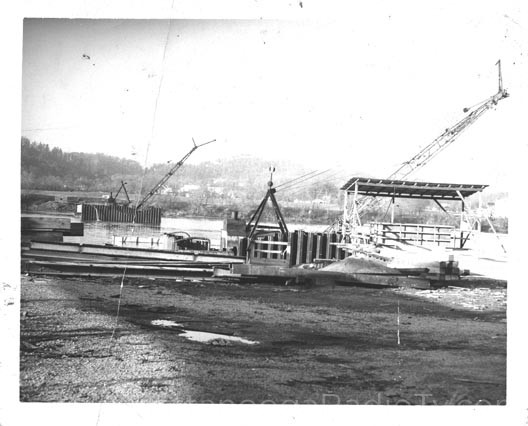During my broadcasting career, I’ve welcomed many new reporters into Chattanooga. Since they’re usually from out of town and I’m pretty much a native, they ask me a lot of questions. Like, “What’s a Soddy Daisy?” And, “Is Georgia still trying to get your water?” Of course, there’s always, “What’s that smell?” if we’re on the South Side near the chicken plant.
But easily the number one question is about that six-lane span over the Tennessee River downtown. The question varies from person to person. Sometimes it’s “Why did they name it the Ol’ Johnny Bridge? Who’s Johnny?” Or, “Why did they name it The Ol’ Jolly Bridge?” That is usually followed by, “I’ve never seen a jolly bridge, it doesn’t make any sense.” I’ve even heard traffic reporters mispronounce the name of our beloved bridge. Officially it’s the Olgiati Bridge, named for Peter Rudolf “Rudy” Olgiati. Pronounced “Ol-Jotty” with a long “O.” So who is this bridge guy?
 There he is, Mr. Olgiati himself. Or you can call him Mayor Olgiati. With a name like that, you’d think he moved here from Pennsylvania or New Jersey, but no. He was born in Grundy County, in Gruetli, Tennessee in 1901. His mother was from Switzerland, his father was from Spain. His father died when he was six, and in 1913 his mother moved Rudy and his two younger brothers to the Alton Park area of Chattanooga. Young Rudy learned the building trade, moving up from bricklayer to superintendent of a large construction company. By the time he was in his thirties, he ran the city’s busiest recreation center, Warner Park. In 1946, he was politically connected enough to be appointed to the City Commission, to fill out an unexpired term. He ran for, and won a full term in 1947, and then took on the incumbent mayor in 1951. He won that race too, and began a three-term, twelve-year run as Chattanooga’s “boss.” That term isn’t used loosely.
There he is, Mr. Olgiati himself. Or you can call him Mayor Olgiati. With a name like that, you’d think he moved here from Pennsylvania or New Jersey, but no. He was born in Grundy County, in Gruetli, Tennessee in 1901. His mother was from Switzerland, his father was from Spain. His father died when he was six, and in 1913 his mother moved Rudy and his two younger brothers to the Alton Park area of Chattanooga. Young Rudy learned the building trade, moving up from bricklayer to superintendent of a large construction company. By the time he was in his thirties, he ran the city’s busiest recreation center, Warner Park. In 1946, he was politically connected enough to be appointed to the City Commission, to fill out an unexpired term. He ran for, and won a full term in 1947, and then took on the incumbent mayor in 1951. He won that race too, and began a three-term, twelve-year run as Chattanooga’s “boss.” That term isn’t used loosely.
J. B. Collins, who covered city politics for the Chattanooga News-Free Press for almost sixty years calls Olgiati “the last of a breed, the last of Chattanooga’s political kings.” Remembering a time when an elected official could control numerous voting precincts, Collins said, “He had power, and he knew how to use it to get his way. He really ran all the city departments. Nobody has that kind of power today.” For most of his first two terms, Olgiati used that power to get the attention of state and federal officials. He went after, and got $100 million in federal grants to build much of the infrastructure that would transform the city. He pushed for an expansion of Chattanooga’s airport, calling the finished product “one of the best in the south.” The 1950s ushered in interstate highway construction across the nation, and Olgiati felt Chattanooga’s close proximity to big cities in every direction should make his city a priority. Chattanooga became the first of Tennessee’s major cities to have a completed interstate system. Then came the bridge.
 The bridge did not come without controversy. The Cedar Street Bridge, as it was known at first, was sorely needed. Since 1949, there was talk of a third downtown span to relieve congestion on the overcrowded Market and Walnut Street bridges. Engineers determined that new road construction could be accomplished in part by cutting off the top half of Cameron Hill, at one time a prominent downtown neighborhood. It had fallen into decline with some of the larger homes having been converted into businesses or divided into rental units. Mayor Olgiati advocated new development along the city’s west side, which would come to be known as the Golden Gateway Redevelopment Project (near today’s West ML King Boulevard). Despite some opposition, portions of the hill were removed to make way for a new highway and bridge. More than a thousand buildings would have to be torn down, and 1,400 families would have to be relocated. The site was approved in 1954, and the four-year project was underway a year later.
The bridge did not come without controversy. The Cedar Street Bridge, as it was known at first, was sorely needed. Since 1949, there was talk of a third downtown span to relieve congestion on the overcrowded Market and Walnut Street bridges. Engineers determined that new road construction could be accomplished in part by cutting off the top half of Cameron Hill, at one time a prominent downtown neighborhood. It had fallen into decline with some of the larger homes having been converted into businesses or divided into rental units. Mayor Olgiati advocated new development along the city’s west side, which would come to be known as the Golden Gateway Redevelopment Project (near today’s West ML King Boulevard). Despite some opposition, portions of the hill were removed to make way for a new highway and bridge. More than a thousand buildings would have to be torn down, and 1,400 families would have to be relocated. The site was approved in 1954, and the four-year project was underway a year later.
 That’s First Baptist Church in the center. The new bridge can be seen at the top of this photo, and in the upper right, you can see Kirkman High School’s athletic fields, now the site of AT&T Field, home of the Lookouts baseball team. Shortly after the bridge opened to traffic in 1959, it was officially named in honor of the mayor, who was at the peak of his political power. He had just won his third term, and had his eyes on a bigger prize: governor of Tennessee. He ran in 1962, losing to Frank Clement. Olgiati’s fortunes did not improve in the 1963 mayoral race, when 34-year-old attorney Ralph Kelley unseated him, sending the “boss” into political retirement at the age of 61. He made one more race, for his old Public Works Commissioner job in 1975, but his time had passed.
That’s First Baptist Church in the center. The new bridge can be seen at the top of this photo, and in the upper right, you can see Kirkman High School’s athletic fields, now the site of AT&T Field, home of the Lookouts baseball team. Shortly after the bridge opened to traffic in 1959, it was officially named in honor of the mayor, who was at the peak of his political power. He had just won his third term, and had his eyes on a bigger prize: governor of Tennessee. He ran in 1962, losing to Frank Clement. Olgiati’s fortunes did not improve in the 1963 mayoral race, when 34-year-old attorney Ralph Kelley unseated him, sending the “boss” into political retirement at the age of 61. He made one more race, for his old Public Works Commissioner job in 1975, but his time had passed.
J.B. Collins said that Olgiati spent much of his later years on a farm in north Georgia, raising Black Angus cattle. He said Olgiati’s only son, Charles preceded him in death, “and Rudy was never the same after that. It took a lot of the wind out of him.” In the 1980s, after the death of his wife Mae, Olgiati moved to Charleston, South Carolina to be near his daughter Virginia. It was there he died in 1989, eighteen days shy of his 88th birthday. He is buried at Chattanooga’s Forest Hills Cemetery.




And now we know. Thanks for sharing.
I was privileged to know Mayor Olgiati in the early 80s when I lived on a farm in Dade County that abutted his. He would drive down from Chattanooga occasionally and I would see him there. He gave me a dog once for the farm. I found the pooch holed up on the creek and started feeding him. I asked Mr. Rudy if he was his dog and he told me he was but that his hired man had beat him until all he was good for was hiding under the truck. He asked me to keep him and feed him and we did. We named the dog Chip and had him as a part of our family until he died.
Thanks for this interesting bit of history. I remember, as though it were yesterday, the big celebration at the ribbon-cutting to open the Olgiati Bridge. I was part of the City HS band, and we played for the event. Chattanooga has changed perhaps more than any city I think of. I remember well all the trains (steam engine-led) criss-crossing the downtown streets, the pervasive odor of coal, the attendant smoke and smog, the ever-burning fires in the multitudinous factories, and the impenetrable darkness of Lookout Creek (?).
What a great transformation Chattanooga has undergone. Bravos galore to the city fathers!
My name is Mario Olgiati & I am wondering if I could be any relation to PR Olgiati. I live in Michigan & I am visiting in Tennessee now. My father was born in northern Italy in the 1890s. If you have any pertinent information please contact me at ava.olgiati@wowway.com
Thank you!